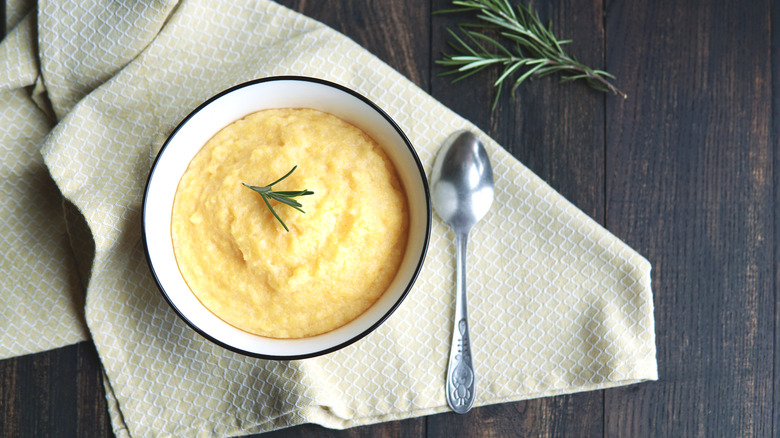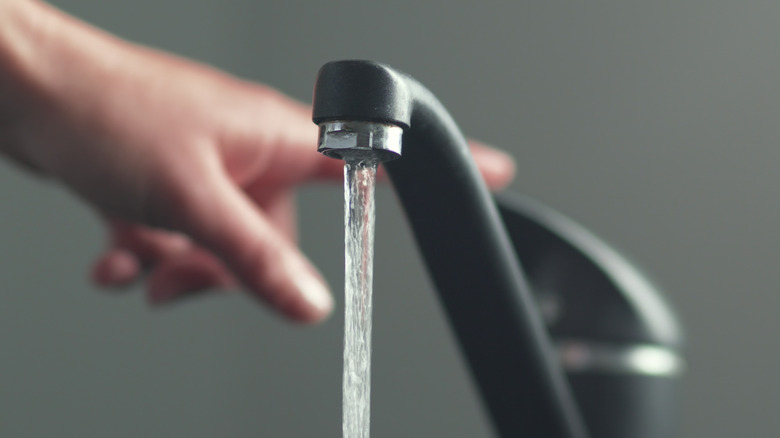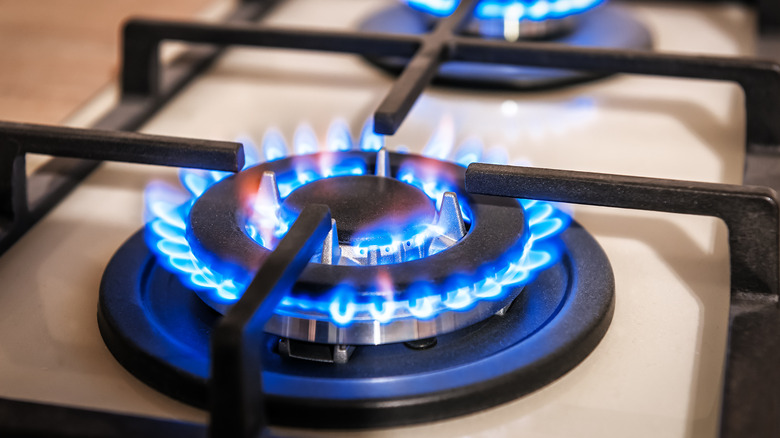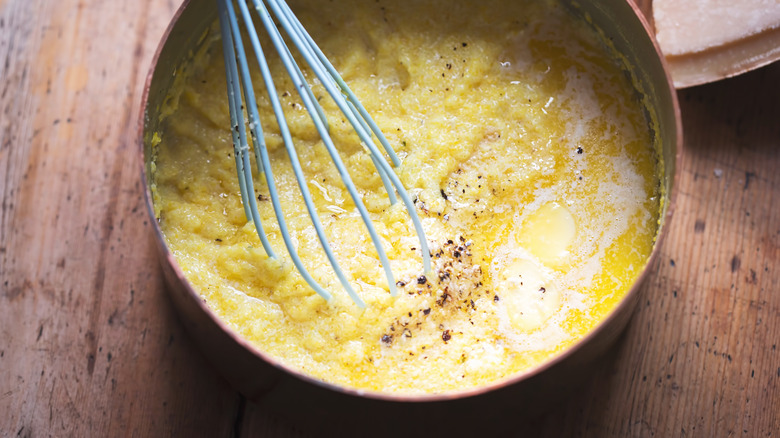Possible Reasons Your Grits Turned Out Runny
Cornmeal, maize, rokahamine, porridge – these are just a few of the names associated with the creamy Southern comfort food known as grits. Its nutty texture and flavor make it enjoyable to eat, and its nutritional value is what brought it to light from the start. A food that was able to feed several people while giving them the proper vitamins such as folate, niacin, pyridoxine, riboflavin, thiamine, and iron made it a 16th-century superfood (via Charleston Mercury).
After making its way to the coastal states of the U.S., grits' cost-efficiency allowed for a cheap breakfast food for Southerners. Once fishermen started eating it with their catch of the day, its pairing with seafood took off, according to Culture Trip. Per The Old Mill, the famed Southern dish shrimp and grits got its start in Charleston, South Carolina, some time around the 1950s.
Now that we know its origins, let's discuss how to prepare it like those Charleston chefs. When you think about a bowl of grits, you want a few things: creaminess, butter-y flavor, and definitely not too thin. Unfortunately, it's pretty hard to get the consistency just right. If you often find yourself with a runny grits consistency, this article is for you. Here are some reasons as to why that stubborn water lingers, ruining your dreams of a shrimp 'n' grits dinner.
You're using too much H2O
According to Quaker, the perfect ratio of water to grits is 2 cups water for every ½ cup grits. When whipping up this creamy classic, oftentimes we as humans like to skip steps to get it done quicker — especially if we're extra hungry. This plays a huge role in why grits end up runny. Eyeballing the amount of water can sometimes make for too much or too little. Adding too much water to your grits at once can leave you in trouble when trying to fix it, especially if you don't have any extra ground grits to throw in there. Adding too little and having tough clumpy grits can be saved by simply adding more water – just not too much.
For when it's too late, however, and you've added too much water to your grits, a potential fix to saving that bad batch is cooking it low and slow over medium-low heat (uncovered) to allow the starch in the cornmeal to finally release. That unwanted water will also have time to evaporate and hopefully concentrate the flavors more. To prevent future bad batches of runny grits, Baking Kneads recommends measuring the water beforehand. While it's an extra step, it'll only add on a few seconds, whereas tossing and making a new grits batch will take way longer.
You're cranking the heat too high
Again, when we're hungry, we want it NOW. And usually that involves high-heat cooking, but according to Just-a-Cook.com, bumping the heat up on your grits might cost you more time remaking them. When you place a pot of grits over high heat, you may think you're on the right track, but this can lead to major overcooking with tough granules and excess water. Grits need time to coagulate, meaning the longer they cook at a steady temperature, the more time they have to drink up that liquid and turn into the creamy bowl of comfort you were craving.
It's similar to meat. When you sear steak or chicken over high heat, you might be left with a charred exterior and a raw interior. When cornmeal cooks too fast, the exterior becomes tough while the starch on the inside is still bottled up waiting to be released, preventing that mashed potato texture.
Try this instead: When you have extra time, get the stone ground grits. These are coarser with zero preservatives, allowing for them to thicken naturally; they require a longer cook time. Cook 'em low and slow until it's the perfect consistency. When you're in a pinch or just really hungry, get the instant grits. These are ground much finer with starches exposed, allowing them to thicken quicker and yield a silky texture in half the time (per Charleston Culinary Tours). Simply follow the packet instructions and you'll have a bowl of bliss in minutes — not too thick and not too runny.
You're not letting it rest
You know the saying to let your meat rest so the juices stay intact? In this case, you want your grits to rest so the juices get absorbed. It can be torture to have a pot of ready-to-eat grits on the stove, but letting them sit off the heat for at least 10 minutes will show you that maybe they weren't ready after all (per Foods Guy). Besides preventing a few burnt tongues, the perk of this tip is to allow the residual heat to work its magic and finish off any bonding needed for that silky smooth texture of Southern grits.
If you're in a rush yet you notice your grits are runnier than normal, not to fret. A few short nukes in the microwave can make for quick thickening. Although, you'll want to cover the bowl with a paper towel when heating, as grits like to bubble up and pop, causing granules to decorate the interior of your microwave. Another tip for when you have that extra 10 minutes to spare is to set a timer and do a quick chore while you wait. You'd be amazed at how quick time flies when you stay busy.
Now that you know why grits can turn runny, and you've now got the consistency down, have some fun with it. Swap in milk for water, or make your own flavors by adding different types of cheeses and herbs to your grifts. Once you've got the perfect concoction, you'll be making non-runny grits with your eyes closed. (But please don't, that's a safety hazard!)



